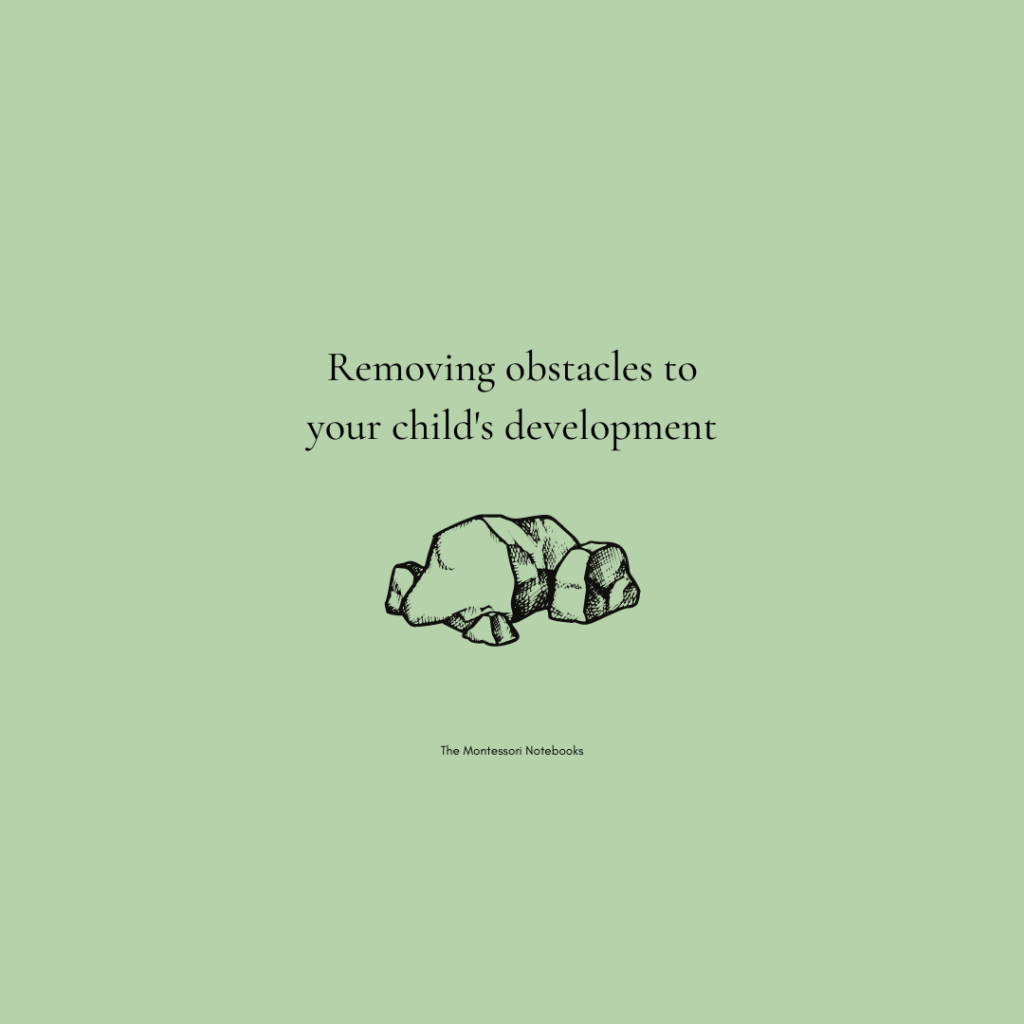Obstacles to your child’s development

Eye spy with my little eye. A different kind of game today. Have you ever tried to spot the obstacles to your child’s development?
Dr Montessori talked about removing obstacles so that the child can reach their full potential.
“The first Right of Man, the Fundamental Right, should recognise the right of the child to be helped to overcome those obstacles which may hinder, repress or deflect his constructive energies thereby denying him the certainty of becoming an efficient, well-balanced adult.”
Maria Montessori, Citizen of the World, p. 54
Obstacles can be physical (for example, not being able to access something for themselves) and they can also be psychological (for example, the adult interfering and being an obstacle ourselves).
So let’s think. Can we set up our home so they can access what they need, from reaching their clothes to get dressed to having activities set out on trays so they can see what’s available rather than rummaging through a toy box?
Obstacles can also be us, the adult. Do we interfere too much so they don’t have the chance to have that feeling of mastery? Do we help them too quickly when climbing at the playground? Or are we not available to step in and help a little so they can get further with what they are working on?
“Every useless help is an obstacle to development”
Maria Montessori, Citizen of the World, p. 34
Here are some more examples to get us started thinking about where there may be other obstacles to our child’s development and what we can do instead to remove them. The obstacles will obviously depend on the age of the child, so adjust accordingly.
Possible obstacles in our home environment
- Not being able to find suitable activities, for example, in a toy box or a cupboard behind a closed door. Instead observing the child, learning what they are practising and their interests, setting up activities to meet these needs, displaying them on an open shelf at their height for them to be able to access and choose independently
- Not being able to access their own clothing. Instead we can set up a dressing area where they can choose their own clothing and dress by themselves.
- Not being able to get a drink or snack when hungry. Instead setting up an accessible space in the kitchen to get a glass of water and have (limited) snacks down low.
- Giving them too much access to water and food. Instead we can put out only as much water as we are happy to help clean up and enough snacks for the day.
- Phones, ipads, tv left in easy access of the children. Instead place them out of reach in a cupboard and display activities to engage the child.
- Clothing that is tight like skinny jeans, difficult to manage independently like overalls and jumpsuits, or can get in the way of free movement like a long dress for a crawling baby. Instead having clothing that is of natural materials, easy to get on and off independently.
Possible non-physical or psychological obstacles
- The adult leading the play or making choices about what to play with. Instead pause as long as needed to allow the child to lead the play and set up activities for the child to make choices for themselves.
- The adult having too much control over the child’s autonomy, for example, not allowing the child choices over their spare time, what they wear, or doing too much for the child. Instead allow the child to make age-appropriate choices so they can feel empowered and give them responsibilities to challenge them, for example, an older child could start to plan the public transport for a family outing (even if they let us get on the wrong bus).
- Not allowing time for the child to explore, to have conversation, or to get bored. Instead have less scheduled activities and long blocks of uninterrupted time to allow these opportunities for exploration, connection and creativity.
- The adult wants them to eat everything on their plate. Instead allow the child to serve themselves and trust they know how much their body needs.
- The adult does not sit with them at meals. Instead make time for family meals, a time to share food and connect with each other.
- Limited opportunities for social experiences. Instead take them to the supermarket where they can help to pay for the groceries, help in a nursing home, assist an elderly neighbour, allow time for friends to come over and bake or build something together.
But….
While we want to remove as many obstacles as possible so they can have success, the duality is to perhaps have a few obstacles remaining so they have opportunities to learn from their mistakes, to be challenged, to solve problems for themselves, or even melt down at times. This is also part of the learning.
So now it’s time to think. What is one obstacle you’ve spotted to your child’s development? And how could you remove it?

Simone Davies has more than 20 years’ experience as an AMI Montessori educator. Simone is the author of “The Montessori Toddler” and co-author of “The Montessori Baby” and “The Montessori Child” books, comprehensive guides to raising children in a Montessori way. She currently runs parent-child Montessori classes in Amsterdam at her school Jacaranda Tree Montessori. She also has a popular blog, instagram and podcast “The Montessori Notebook” and is mother to two young adults.